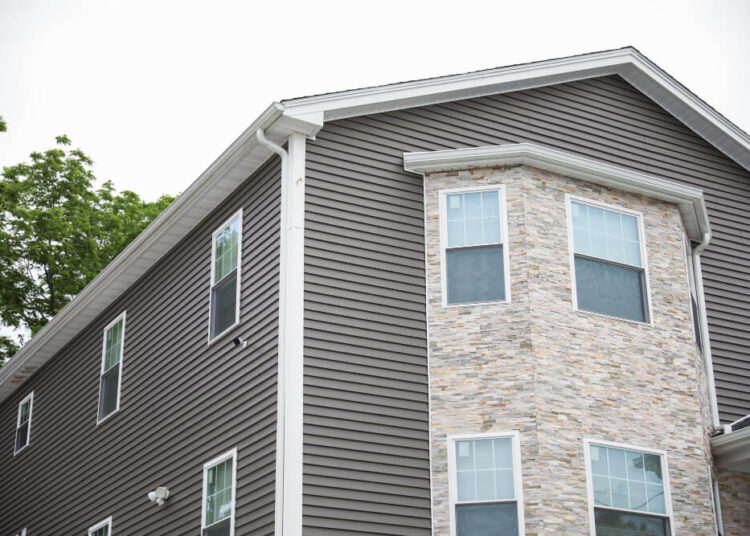As white exterior siding takes center stage, this opening passage beckons readers into a world crafted with good knowledge, ensuring a reading experience that is both absorbing and distinctly original. White exterior siding offers a versatile and timeless aesthetic that can transform any home's exterior.
From classic to contemporary styles, the options are vast and varied, catering to different tastes and preferences. Let's delve into the realm of white exterior siding to discover its types, design trends, maintenance tips, and environmental impact.
Types of White Exterior Siding
When it comes to white exterior siding options, there are several materials to choose from, each with its own set of features and benefits. Let's explore the different types of white exterior siding available in the market.Vinyl Siding
Vinyl siding is a popular choice for homeowners due to its affordability and low maintenance requirements. It is available in a wide range of colors, including white, and is resistant to rot, insects, and fading. However, vinyl siding can crack or warp in extreme temperatures and may not be as durable as other materials.Wood Siding
Wood siding provides a natural and classic look to a home and can be painted white for a clean, traditional appearance. It is environmentally friendly and offers good insulation properties. On the downside, wood siding requires regular maintenance, such as painting or staining, to prevent rot and decay.Fiber Cement Siding
Fiber cement siding is a durable and low-maintenance option that can be painted white to mimic the look of wood or other materials. It is resistant to fire, insects, and moisture, making it a long-lasting choice for homeowners. However, fiber cement siding is heavier and more expensive than vinyl or wood siding.Metal Siding
Metal siding, such as aluminum or steel, is a sleek and modern choice for white exterior siding. It is resistant to fire, rot, and insects, and can be easily painted or coated for added protection. Metal siding is durable and long-lasting, but it may dent or scratch easily, requiring repairs or replacements.Design Trends and Styles
White exterior siding has become a popular choice in modern architecture due to its versatility and timeless appeal. The clean and crisp look of white siding can greatly enhance the curb appeal of a home, giving it a fresh and modern aesthetic. Let's explore how different design trends and styles can be achieved with white exterior siding.Contemporary Minimalism
In contemporary architecture, white siding is often used to create a minimalist look. The simple and clean lines of white siding can help achieve a sleek and modern appearance. Paired with large windows and minimalistic landscaping, white siding can create a striking contrast and a sense of openness.Cottage Charm
For a more traditional or cottage-style home, white siding can bring a sense of charm and character. Whether using horizontal lap siding or board and batten siding, the white color can evoke a cozy and inviting feel. Pair it with a front porch, shutters, and colorful accents for a classic and welcoming look.Modern Farmhouse
The modern farmhouse style has gained popularity in recent years, and white siding plays a key role in achieving this aesthetic. Combining white siding with metal roof accents, black window frames, and a front porch with a metal roof can create a modern farmhouse look that is both stylish and inviting.Coastal Elegance
White siding is a popular choice for coastal homes, as it can evoke a sense of beachy elegance. Pairing white siding with blue accents, cedar shingles, and a front porch with white columns can create a coastal-inspired look that is bright, airy, and sophisticated.Maintenance and Care Tips
Maintaining white exterior siding is crucial to preserving its color and quality over time. Regular cleaning and preventive measures can help prevent issues like discoloration or mold growth.Cleaning Frequency
- Cleaning frequency for white vinyl siding: It is recommended to clean white vinyl siding at least once a year to remove dirt, grime, and mildew buildup. For areas with high humidity or pollution, more frequent cleaning may be necessary.
- Cleaning frequency for white aluminum siding: White aluminum siding should be cleaned every 6 to 12 months to prevent oxidation and corrosion. Regular cleaning can also help maintain its shine and appearance.
- Cleaning frequency for white wood siding: White wood siding requires more frequent cleaning, at least twice a year, to prevent mold growth, rot, and discoloration. It is essential to remove debris and moisture regularly to protect the wood.
Preventive Measures
- Inspecting for damage: Regularly inspect white siding for any signs of damage, such as cracks, chips, or peeling paint. Prompt repairs can prevent further deterioration and maintain the integrity of the siding.
- Proper ventilation: Ensure proper ventilation around white siding to prevent moisture buildup, which can lead to mold growth and discoloration. Trim vegetation away from the siding to allow air circulation.
- Use mild cleaning solutions: When cleaning white siding, avoid harsh chemicals that can damage the surface. Opt for mild detergent solutions and a soft brush or cloth to gently scrub away dirt and stains.
Environmental Impact and Sustainability
White exterior siding materials can have varying environmental impacts based on their production processes and disposal methods. It is essential to assess the sustainability of these options to make informed choices for your home.Environmental Impact of Different White Siding Materials
- Vinyl Siding: Vinyl siding is a popular choice due to its affordability and low maintenance. However, the production of vinyl releases harmful chemicals into the environment, and it is not biodegradable.
- Fiber Cement Siding: Fiber cement siding is durable and resistant to rot and pests. Although it requires energy-intensive production, it is long-lasting and recyclable.
- Wood Siding: Wood siding is a natural and renewable option. However, deforestation and chemical treatments can have negative environmental impacts.
Sustainability of White Exterior Siding Options
- Recyclability: Opt for siding materials that are recyclable to reduce waste and promote sustainability.
- Eco-Friendly Production: Choose siding options that require minimal energy and resources during production to lower their environmental footprint.
- Longevity: Select durable siding materials that have a long lifespan to minimize the need for frequent replacements and reduce overall environmental impact.
Eco-Friendly Alternatives for White Siding
- Recycled Plastic Siding: Utilizing recycled plastic materials for siding can help reduce plastic waste and promote a circular economy.
- Bamboo Siding: Bamboo is a sustainable and rapidly renewable resource that can be used as an eco-friendly alternative to traditional siding materials.
- Cork Siding: Cork is a natural insulator with sound-absorbing properties, making it an environmentally friendly choice for white exterior siding.









